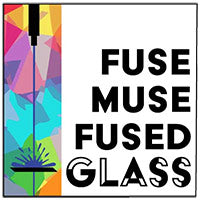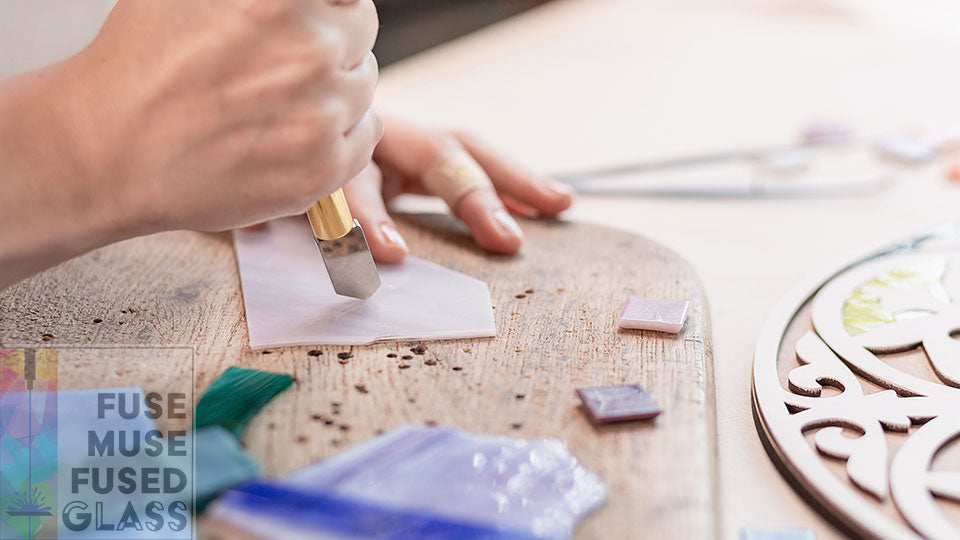Welcome to the fascinating world of glass fusing!
Have you ever come across the term "COE" while diving into the art of fusing glass? If you're new to this captivating craft or even a seasoned fusing enthusiast, understanding the concept of "COE" is essential for successful and mesmerizing glass creations. Here at Fuse Muse Fused Glass, we're not only passionate about fusing; we're also dedicated to empowering the fusing community with knowledge and top-quality supplies. From precut glass shapes to intricate silk screens, we're thrilled to offer everything you need to elevate your glass fusing endeavors to new heights. Let's delve into the world of COE and unravel its significance in the realm of glass fusing!
What COE Stands For in Glass Fusing
If you are just starting out glass fusing, you’ll have to learn the basics.
One of the most important technical aspects of Glass Fusing is COE. COE stands for Co-Efficient of Expansion.
In physics terms, Coefficient of Expansion describes how much a material will expand for each degree of temperature increase.
So what does this mean in relation to glass?
Glass expands when it gets hot and contracts when it cools, which results in a change in density.
Measured in a laboratory, this figure would be miniscule and very, very long, so for ease they are shortened to whole numbers – COE 90 or COE 96, for example.
Each type of glass has a different COE – most Oceanside glass, for example, is said to have a Coefficient of Expansion of 96.
Bullseye Glass has a COE of around 90, while standard window glass has a COE that is around 84-87, depending on the manufacturer. The COE of a glass determines the basic scheduling rules for heating and cooling your glass.
Following these rules will allow the molecules to realign and prevent stress which leads to breakage.
Fusing Temperatures
In fusing glass there are some basic temperatures that certain processes occur. As temperature increases and decreases it will go through many different forming situations.
The first major one is slumping which occurs beginning approximately 648 degrees Centigrade (1200 Fahrenheit).
Slumping is when sheet glass is laid over a mold and put in a kiln, as the glass is heated, gravity pulls it down into the mold. Slumping is usually the last of the fusing processes.

The next process is called tack fusing. This is when two pieces of glass will actually stick together. The edges will also start to soften and round. This usually starts at about 704 degrees Centigrade (1300 degrees Fahrenheit).
As glass is heated to a higher temperature, a full fuse occurs. This is when the glass will have flowed together into a single height of approximately 6mm (1/4") and formed with rounded edges.

The final step after going through one or more of these processes is annealing. Annealing temperature is truly based on the COE of the glass and the length of time held at that temperature depends on how thick your glass is. So annealing is manufacturer specific.

Bullseye Vs Spectrum System 96
Overview of the different manufacturers
There are two main manufacturers and a handful of smaller companies in the glass fusing world.
To keep things simple we will only refer to Oceanside Glass and Tile and Bullseye Glass.

Oceanside Glass & Tile® (OGT) is a leading manufacturer of specialty sheet glass for art and architecture. Using a unique combination of traditional hand crafted methods combined with modern glass making technology, OGT produces a full, contemporary line of fusible sheet glass and glass accessories, in addition to glass blowing materials.
Their products have a reputation for delivering top quality performance, offering a wide range of choices and inspiring artistic expression for glass artists around the globe. Oceanside Glass is manufactured in Mexico.

Bullseye Glass Company is a manufacturer of colored glass for art and architecture with worldwide distribution and a strong commitment to research, education, and promoting glass art. Their glass is handcrafted in our factory, based in Portland, Oregon.
Since 1974, they have collaborated with a community of artists worldwide and have been instrumental in developing many of the fundamental materials and methods at the core of contemporary kiln-glass.
They are widely known as the first company in the world to formulate and manufacture glass that is factory-tested for fusing compatibility. They are also recognized for key contributions to the kilnforming, kilncasting, flameworking, and coldworking methods used to create glass art.
In addition, Bullseye collaborates with a community of artists around the globe to produce quality art glass and promote quality glass art.
Which Coe To Choose?
Which coe to use for various projects, stained, fusing, and mosaics
Choosing a manufacturer and subsequent COE is completely a personal choice.
There are many factors that can influence your decision to choose either one or both of these glasses.
-
Availability - For many individuals, this is the very thing that decided which type of glass to use. If you only have one local store that sells glass for fusing, and it only sells one manufacturers glass, it can be a simple choice.
If you do not have a glass store that you would like to shop at you can choose to ship the glass to you or pick it up. Many retails stores will ship glass to you and it is up to you to decide who you would like to order from.
- Price - Years ago, many people chose Oceanside Glass (formerly owned by Spectrum Glass) due to it's cheaper price per square foot. As time goes on and prices rise, there is not so much of a difference anymore and so hobbyists and professionals alike can choose whatever glass they like.
- Color Choice - Currently Bullseye has the upper hand in color choices. This manufacturer has around 150 different colors and shades of glass. Oceanside has many fewer colors and shades, but continues to add colors and blends regularly.
- Ease of use - For many beginner glass fusers, one of the issues that can cause anxiety is their ability to cut and break glass. Although up to the individual, is can be said that
Oceanside and it's flat glass without texture is easier to cut and subsequently break. Bullseye glass has a texture on the glass that can cause someone with little glass experience issues with cutting.
The white glass from Bullseye is often behind this issue as anyone who has had a piece of glass "run" on them.
Most fuser's prefer to only use one type of glass so they don't run into incompatibility problems. Some of us are more adventurous and are better at keeping their glass separated by manufacturer.
Can You Mix COE 90 and COE 96 Glass?
COE90 and COE96 Glass compatibility
We supply both COE 90 Glass shapes and COE 96 glass Shapes so you can be sure to get what ever you need for your project.
As discussed above you can only use one COE of glass in a piece.
To keep things simple we will say you are not able to mix glass from different COE's. This is due to the annealing temperature.
As glass cools the molten molecules become solid molecules. If one was to mix the two COE's the solid glass and molten glass would not cool at the same temperature and would crack.
This is what we call incompatibility.
It can happen in your kiln while cooling, or it can wait and happen much later than that, but it will crack. Alas, this is where you learn about the "cry factor" and how "praying to the kiln gods" will not help you.

As we conclude this exploration into the world of COE in glass fusing, we hope that the information provided has shed light on an essential aspect of glass fusing. At Fuse Muse Fused Glass, we take immense pride in supporting the fusing community with top-notch supplies and resources. Whether you're a seasoned artist or just beginning your glass fusing journey, understanding the COE concept will undoubtedly enhance your creative endeavors. Don't forget to check out our website for all your silk screen needs and precut shapes in COE 96 and COE 90. Fuse on!
References:
Bullseye Glass
http://www.bullseyeglass.com/images/stories/bullseye/PDF/TechNotes/technotes_04. pdf
Oceanside Glass and Tile
https://oceansidecompatible.com/pages/products
Glass Campus
https://www.glasscampus.com/tutorials/pdf/FIRING%20SCHEDULES.pdf Merriam Webster Dictionary
https://www.merriam-webster.com/dictionary/coefficient%20of%20expansion
Additional keywords: Fusible Glass, Fusing, Kiln, Sheet Glass, Stained Glass, Spectrum Glass, Oceanside
------------------------------------------------------------

------------------------------------------------------------


5 comments
Thank you so much for this interesting article. It has made understanding the various types of glass so much easier. I’ve been attending a glass fusion class for approximately a year and love working with it but I now feel I understand the whys and wherefores much more!
Muchas gracias por la información, muy útil
New to fusing. Thankful for information.
Thank you for sharing this important information 🙏
Very informative. Thank you